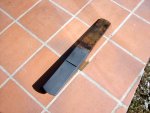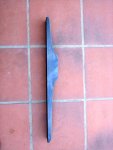Jerry Palmer
Member
- Messages
- 317
- Location
- Cedar Park, TX
Ken:
I had the chance to play with Griz's setup when he helped me restore those hand planes earlier.
My question was about whether or not electrolysis is a line of sight phenomenon. I didn't think it was. I did a little research to convince myself that it isn't and found this interesting electrochemistry site: http://www.chem1.com/acad/webtext/elchem/
In the electrolysis section there is a picture showing that most ion (charge) movement in solution is due to diffusion, essentially a random motion. So it shouldn't matter where the rust is relative to the other electrode - if the rust is in solution it should eventually get electrolytically removed.
I've been learning more chemistry from my hobbies lately than from my career as an analytical chemist - it's fun.
What I can say to that is many of the sites I used as reference when I set my tank up had indicated that it was line of site and mentioned current flows, which are electron flows and they like to take the path of least resistance between where they're goin and where they're comin from. That would indicate a straight line through the solution. There were also references to using iron or steel tubs as the anode and filling the tub with your solution, suspending the item to be derusted with contacting the tub/anode in order to get cylindrical coverage of electron flows.
The couple of saws I derusted before I nearly ruined one from hydrogen hardening, seemed to want to be flipped partway through the process in order to get both faces done. As well, I found I still had rust often times inside of small threaded holes in hand plane bodies after spending a day or so in the tank. This evidence sorta backed up what I had read.






